California DMV Permit Test
1/124
There's no tags or description
Looks like no tags are added yet.
Name | Mastery | Learn | Test | Matching | Spaced |
|---|
No study sessions yet.
125 Terms
Broken yellow lines mean...
Passing is allowed if done safely
A traffic signal with a flashing yellow arrow means...
Proceed with caution
What is the use of the special "turnout" areas marked on a two-lane road?
a. To allow vehicles to make a U-turn
b. To allow vehicles behind the driver to pass
c. To allow vehicles to make a left turn
b.
When two vehicles meet on a steep mountain road where neither can pass, which vehicle has the right-of-way?
a. Both
b. The vehicle which comes first
c. The vehicle traveling downhill
d. The vehicle traveling uphill
d.
When you see this sign, you should:
a. Accelerate to merge with traffic
b. Yield to traffic and pedestrians on the through road
c. Make a sharp turn to match the speed of the traffic on the highway
d. Road entering from the right
D
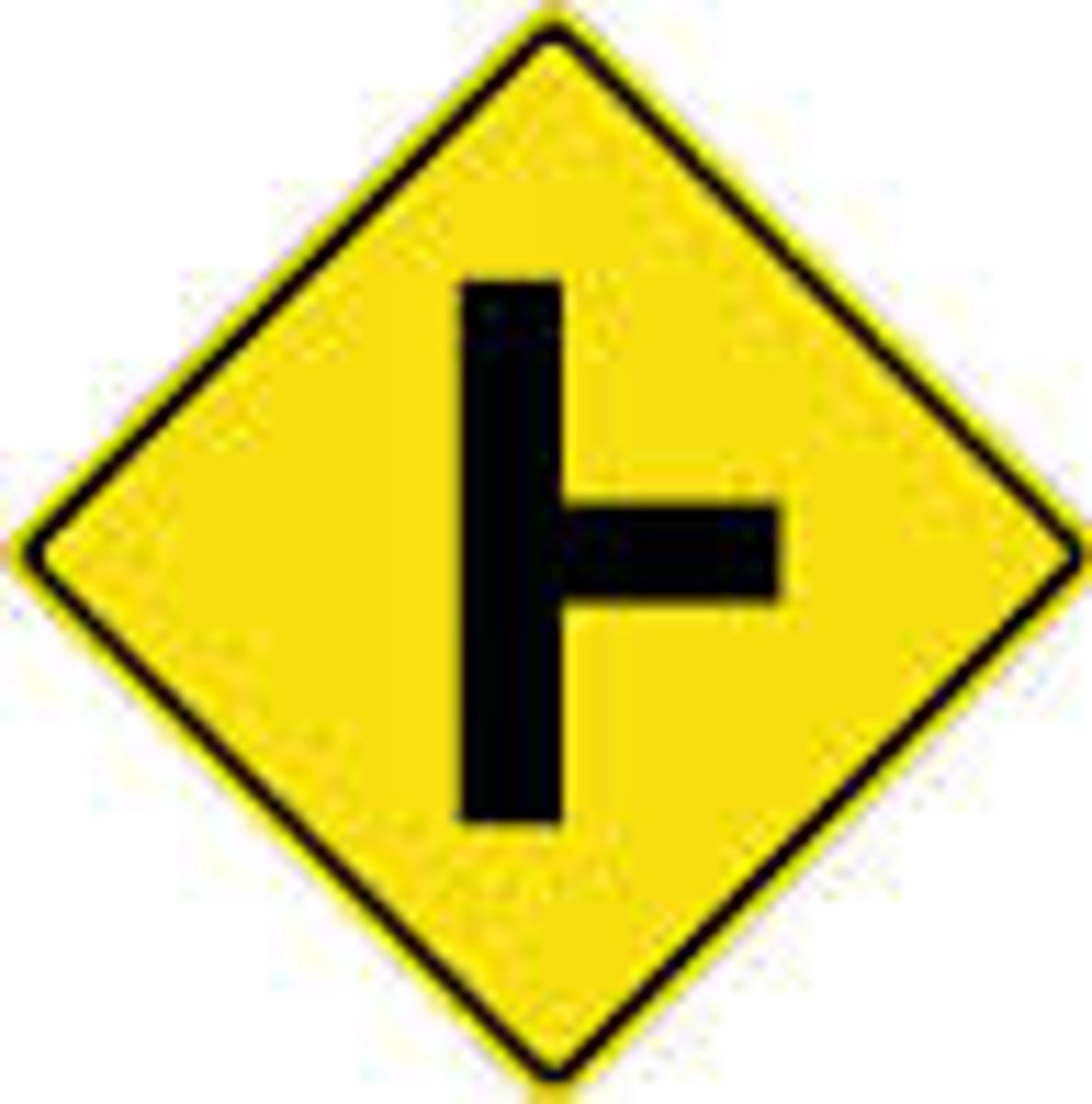
This warning sign represents: ending divided highway
a. Beginning of a two-way lane
b. Beginning of a divided highway
c. Ending of a divided highway
d. Beginning of a one-way lane
c.
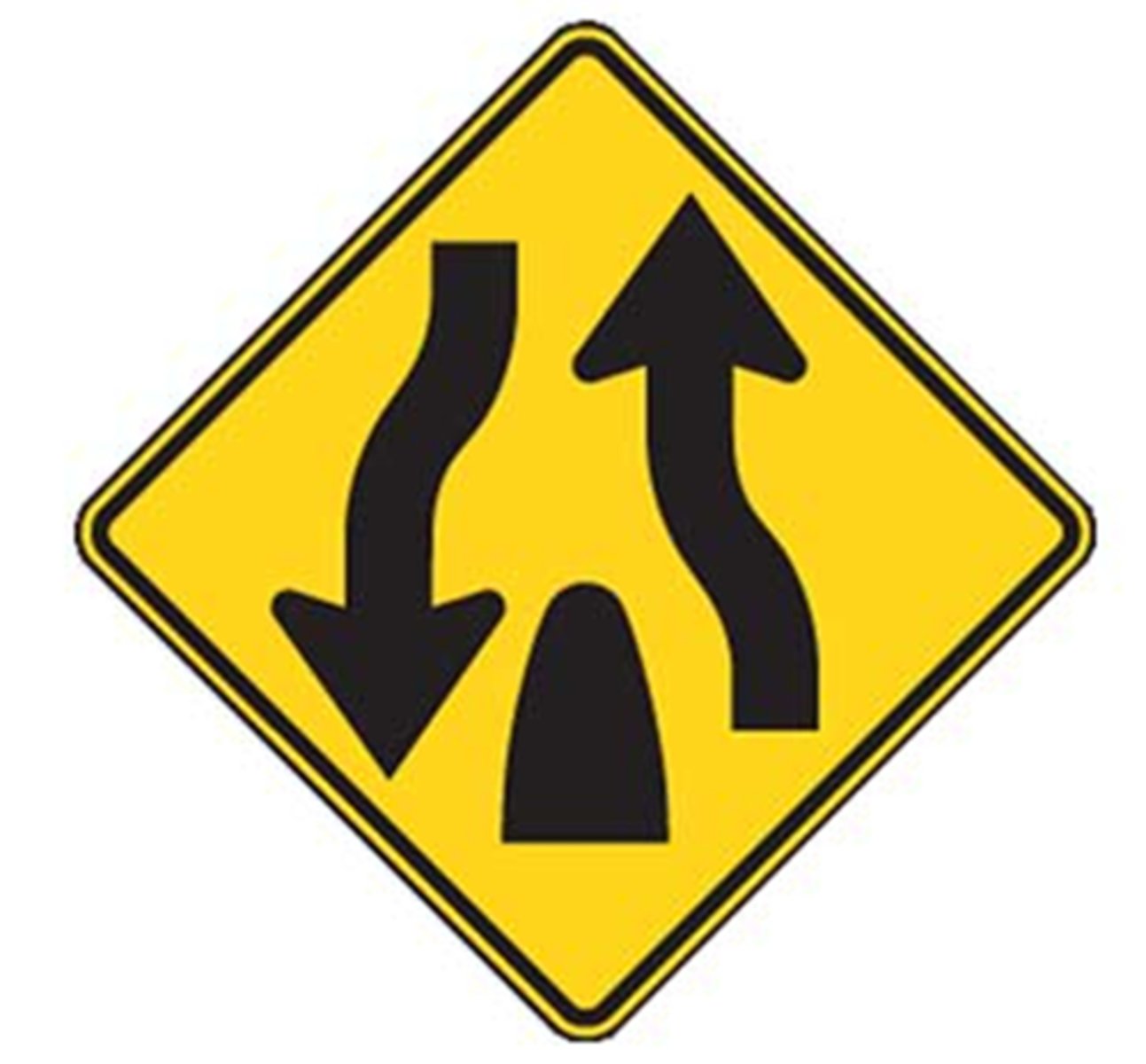
Left turns at a red light can only be made from a:
a. Two-way street onto a one-way street
b. One-way street onto a two-way street
c. One-way street onto a one-way street
d. Two-way street onto a two-way street
c.
Two sets of solid, double, yellow lines spaced two or more feet apart indicate:
a. Two-way traffic
b. A barrier
b.
If you are having vehicle trouble, first thing you should do is...
a. Pull off the road and away from traffic
b. Lift the hood to signal an emergency
c. Check your driver's manual for help
d. Stop your vehicle over a hill or just around a curve for visibility
a.
This sign warns the driver that it is a: winding
Winding road
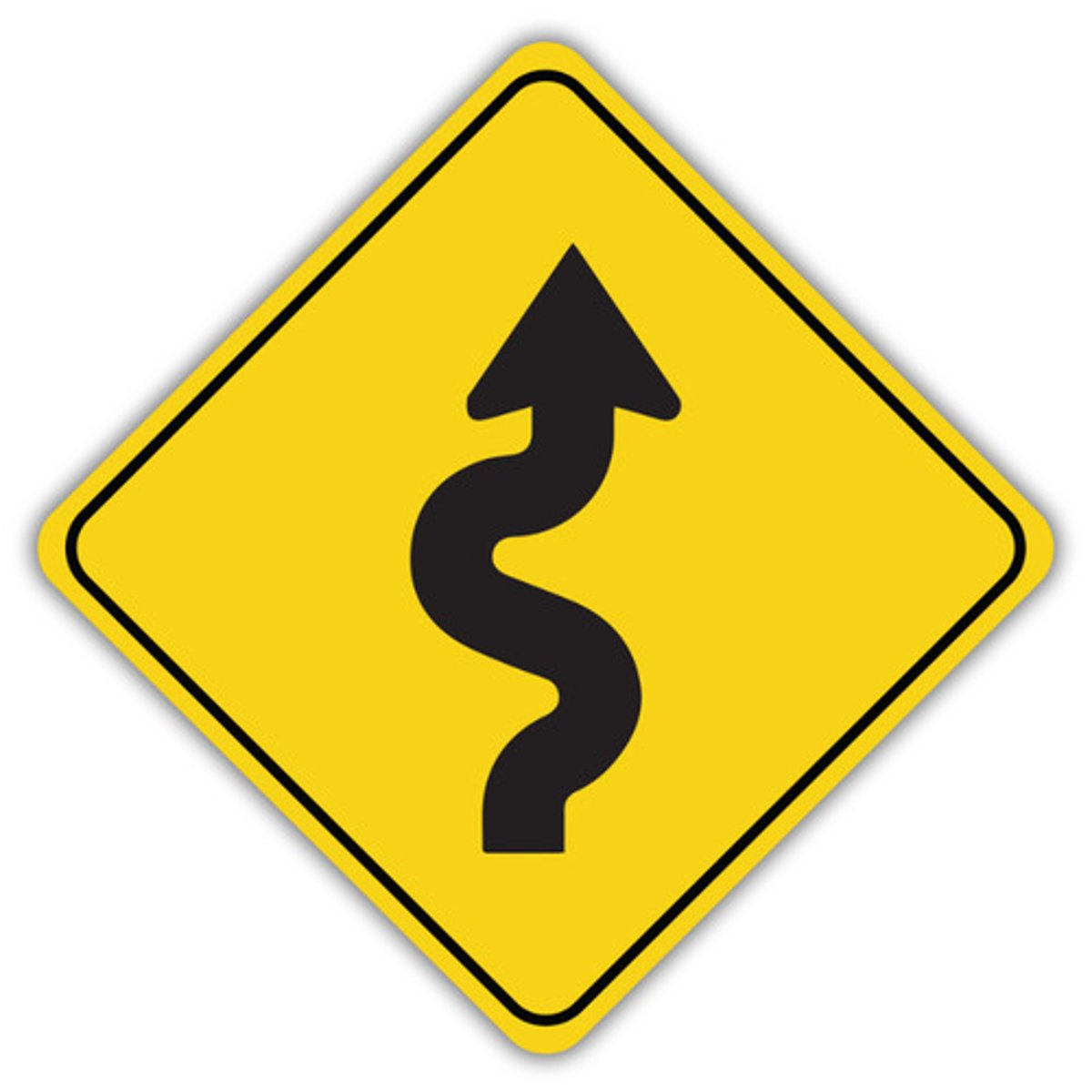
A driver who is involved in a collision should report it to the DMV within:
a. 20 days
b. 15 days
c. 10 days
d. 30 days
c.
Disabled people with their placard can park at a _________ painted curb
Blue
If a bicycle on your right reaches the intersection at the same time as you do, you should:
a. Move slowly along with the bicycle
b. Request the bicyclist to change lanes
c. Move because you have the right-of-way
d. Yield to the bicycle
d.
The maximum speed limit for vehicles towing trailers is _____ on a two-lane undivided highway:
a. 55 mph
b. 70 mph
c. 65 mph
d. 60 mph
a.
To avoid tailgating, one should follow the:
a. 6 second rule
b. 2 second rule
c. 4 second rule
d. 3 second rule
d.
This sign indicates: yield
Yield
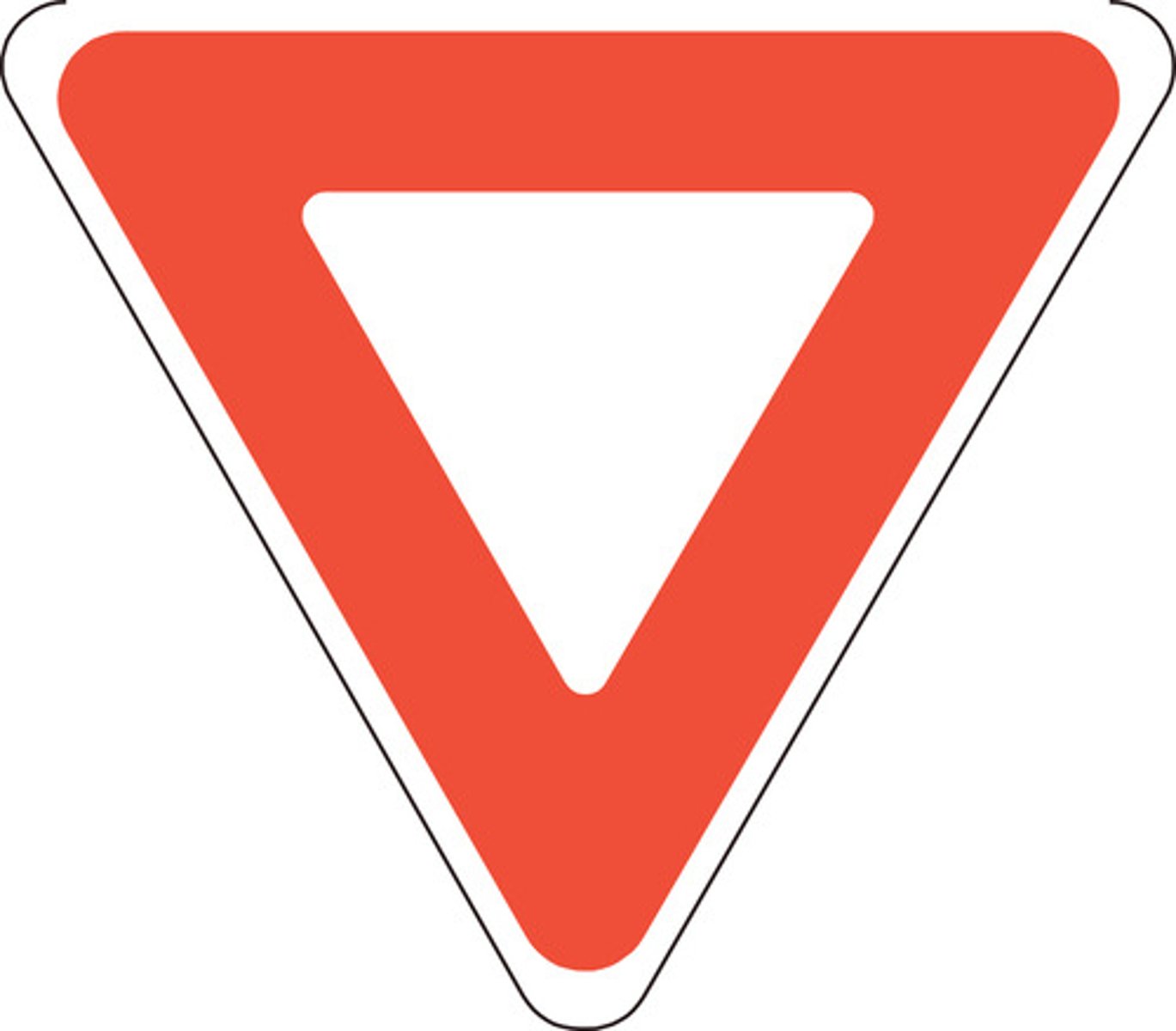
The first step a driver should do during an enforcement stop is:
a. Turn on the right turn signal
b. Turn on the left turn signal
c. Stop on the left shoulder of the freeway
d. Stop on the center median of a freeway
a.
If you are in an intersection and hear the siren of an emergency vehicle, you should:
a. Move to the left and stop in the intersection
b. Move to the right and stop in the intersection
c. Continue through the intersection, then drive to the left and stop
d. Continue through the intersection, then drive to the right and stop
d.
When drivers see livestock, they should:
a. Turn safely away from these animals
b. Signal the person in charge of these animals to move right
c. Follow directions from the person in charge of these animals
d. Blow the horn continuously until the animals cross the road
c.
When you want to enter a freeway, you should:
a. Enter the freeway at or near the speed of the freeway traffic
b. Stop before merging into freeway traffic
c. Enter the freeway with a minimum speed
d. Stop and yield to the traffic in the freeway
a.
At an unmarked crosswalk, drivers are required to:
a. Increase the speed of their vehicle and cross before the pedestrians
b. Stop and request the pedestrians to cross quickly
c. Signal their intention and proceed
d. Yield the right-of-way to the pedestrians
d.
A ________ sign on a truck means that the load on the truck is potentially dangerous:
a. diamond-shaped
b. red inverted triangle
c. white rectangle shaped
d. octagon-shaped
a.
While driving in the fog you should use your:
a. low-beam lights
b. high-beam lights
c. parking lights
d. emergency flashing lights
a.
A child under the age of 8 years ___________, when all the rear seats are already occupied by children under the age of 7 years:
a. May be kept on the lap of the elder child, with a seatbelt fastened to both
b. May ride in the front seat without a seatbelt
c. May ride in the front seat of a vehicle
d. Should be kept at home
c.
Which of the following signs represents two-way traffic?
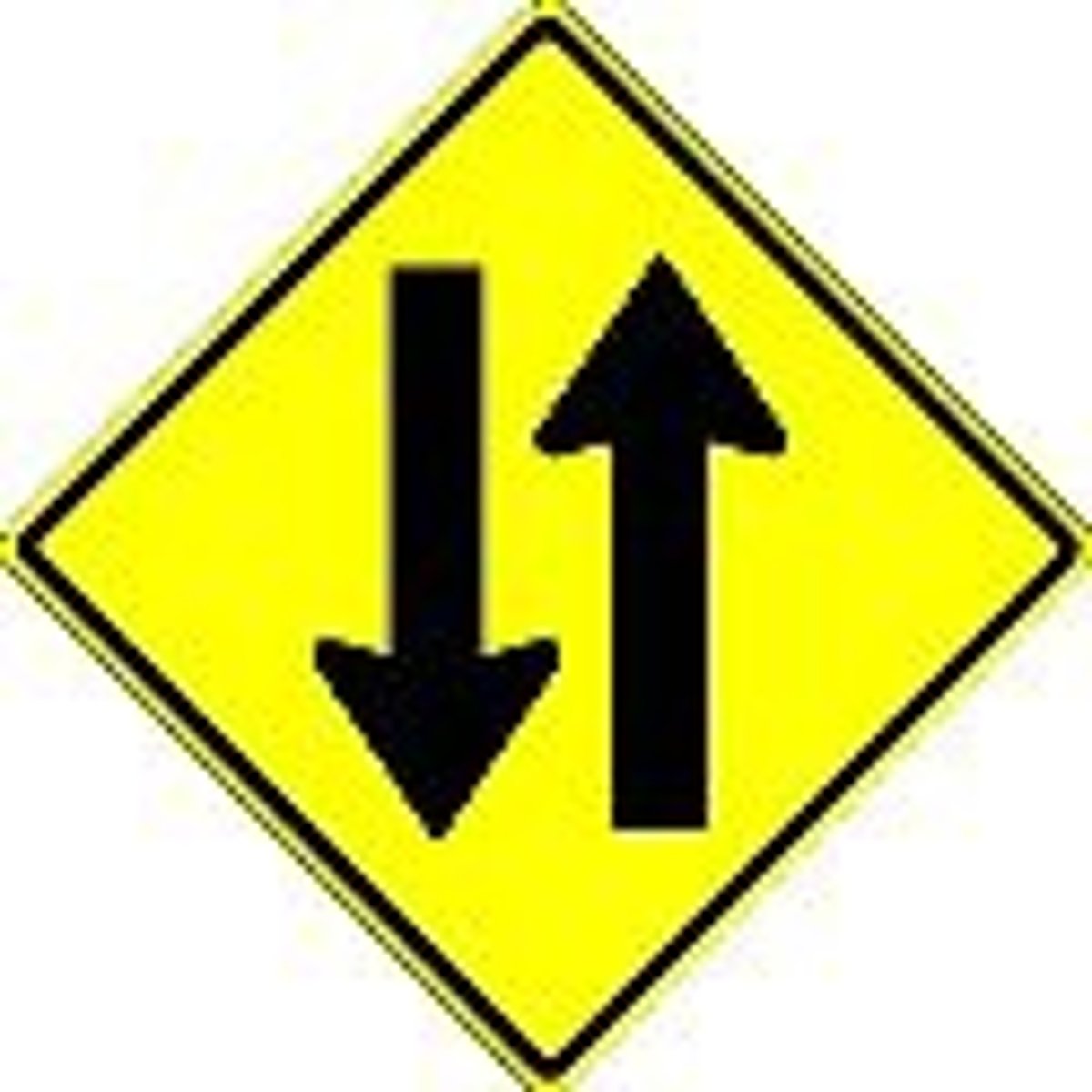
You must use your headlights _________ after sunset:
a. 30 minutes
b. 15 minutes
c. 20 minutes
d. immediately
a.
If you litter on the roadside, you are subjected to a fine of:
a. $1,500
b. $1,000
c. $500
d. $600
b.
A driver who is a minor receives a phone call on hid/her cellphone. He/she should:
a. Use a hands-free cellphone to answer the call
b. Answer the call in an emergency
c. Not answer the call
d. Not be carrying a cellphone while driving
c.
What does this warning sign mean? Stop sign
Stop sign ahead
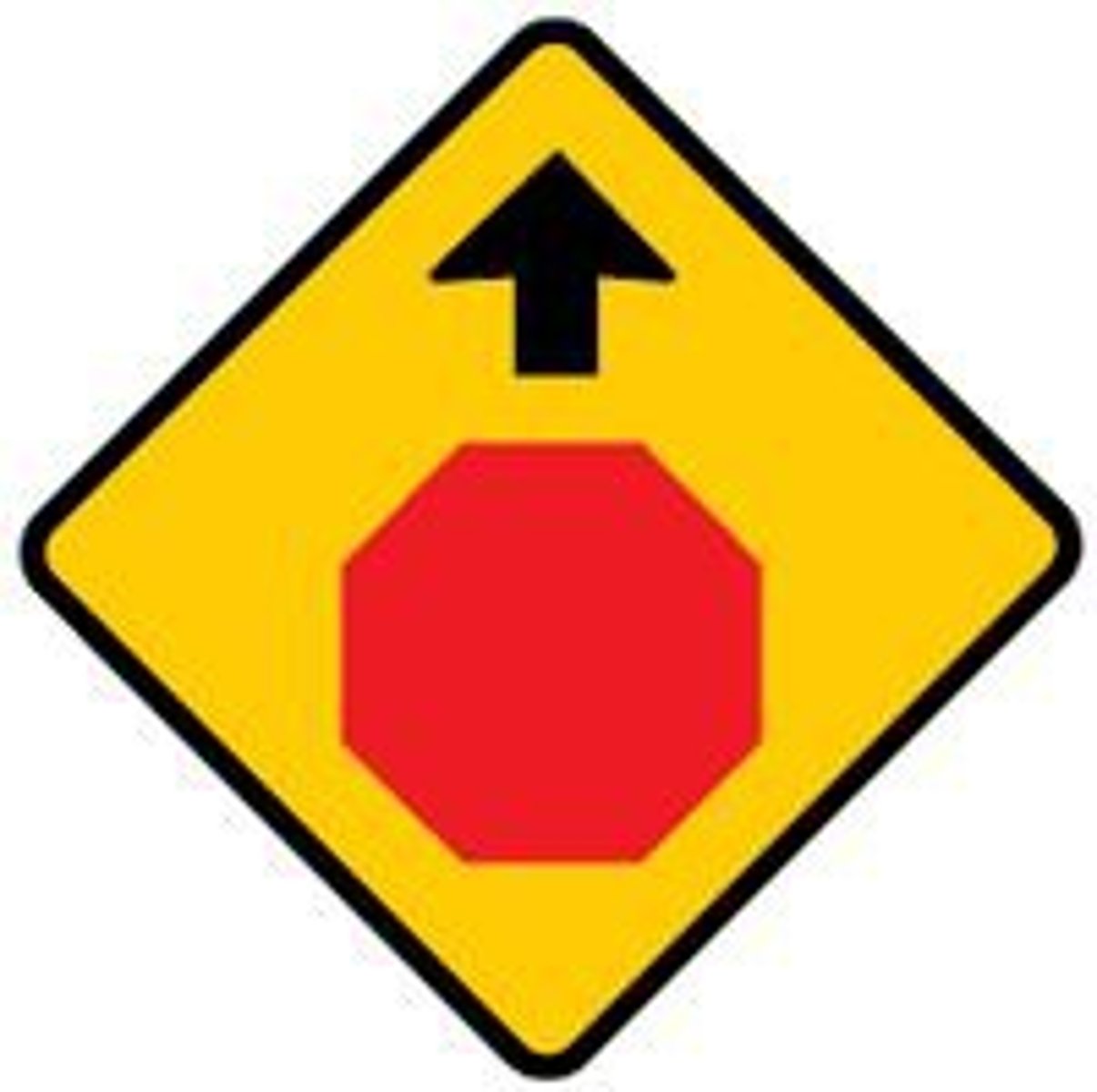
Use ___________ steering when correcting a skid:
a. Hand-by-hand
b. Hand-over-hand
c. One-hand
d. Push-pull
b.
This sign represents: schoolzone
A schoolzone
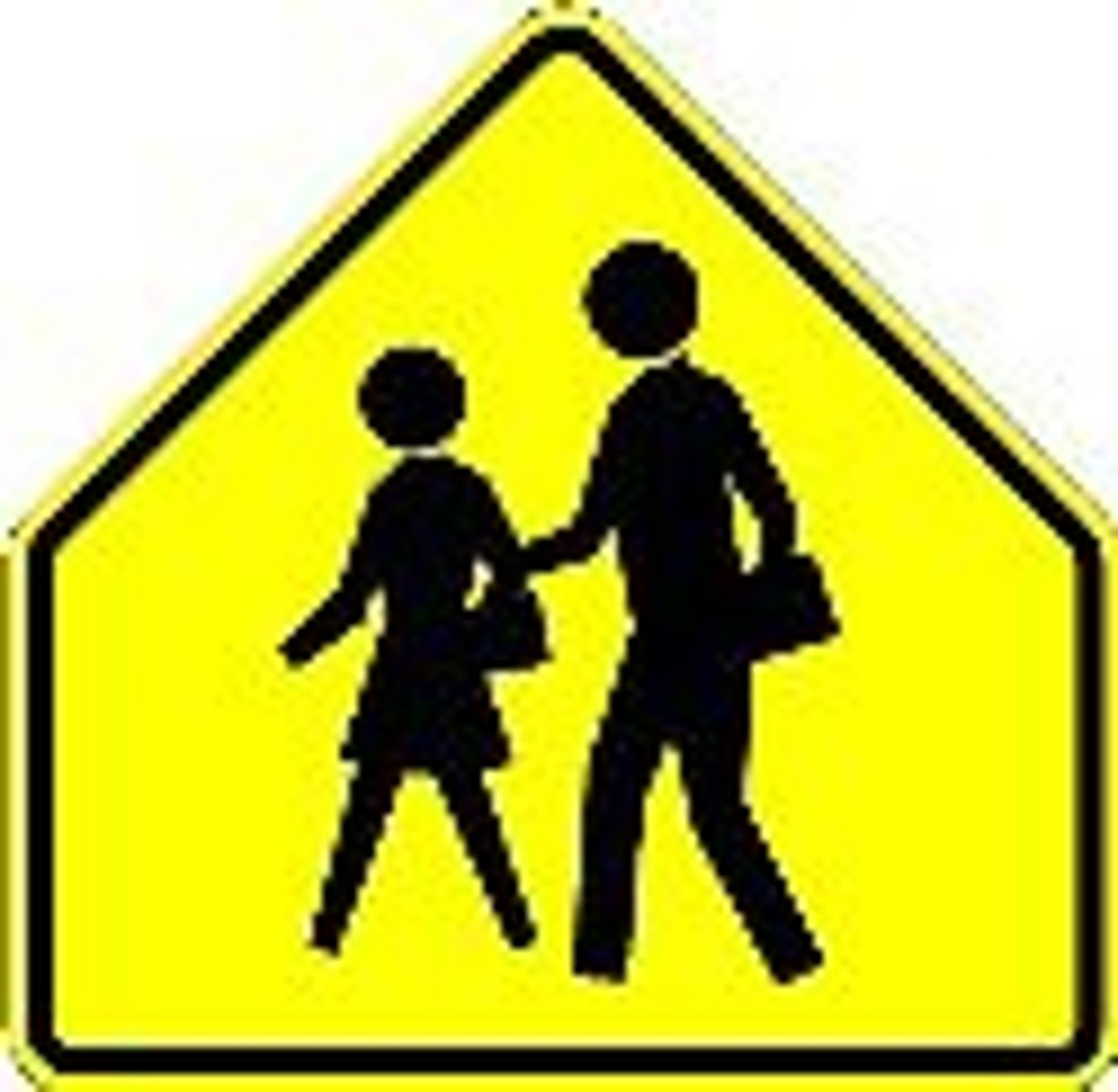
Before passing another vehicle:
a. Pass on the left if the driver is signaling a left turn
b. Look ahead for road conditions and traffic
c. Drive off the paved or main-traveled portion of the road
d. all of the above
b.
This regulatory sign represents: no u turn
No U-turn
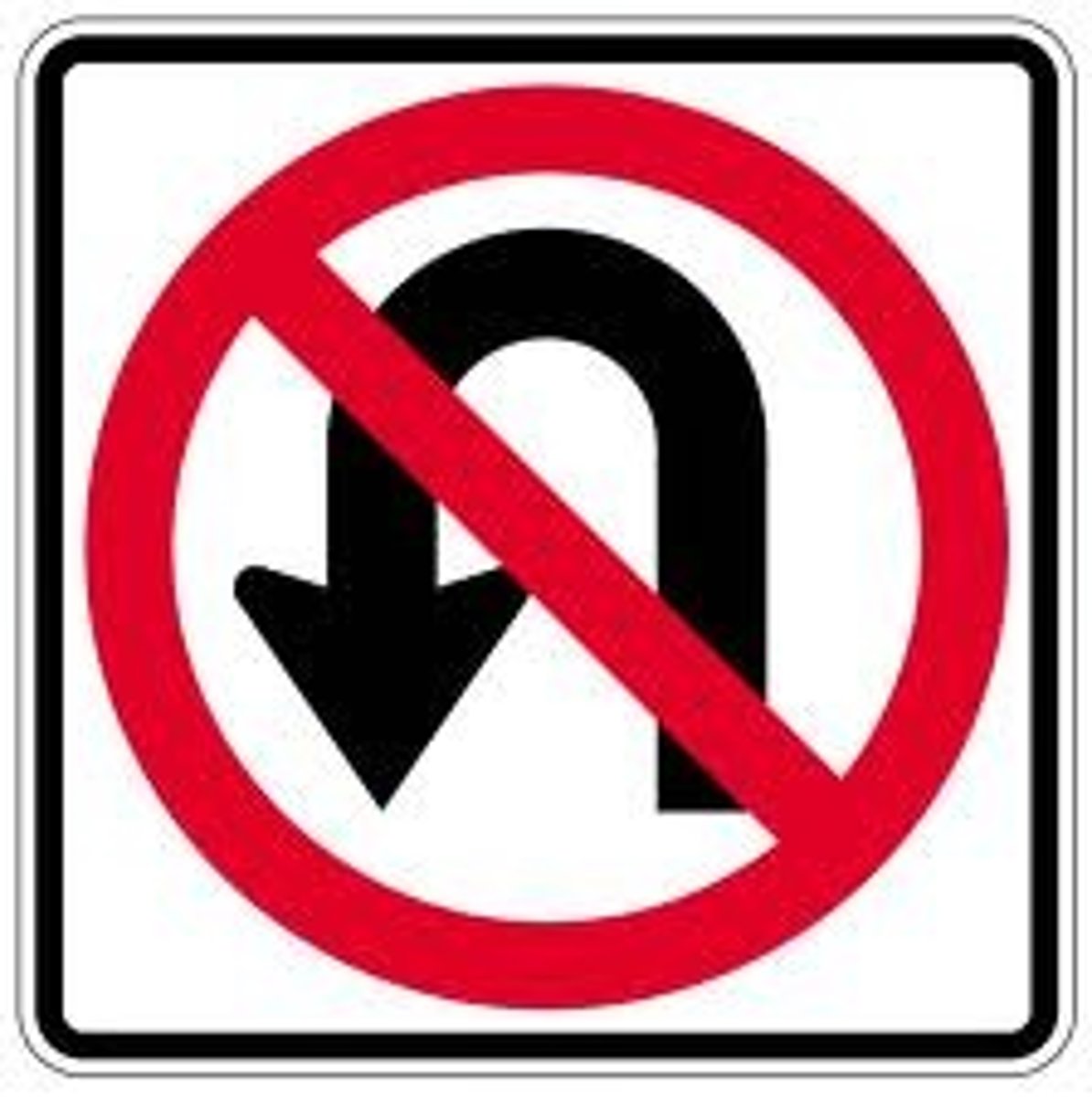
Locked wheel skids are usually caused by:
a. Braking too hard at a high speed
b. Leaking motor oil
c. Pressing the gas and brake pedals at the same time
d. Ignition turned to the lock position while the vehicle is still in motion
a.
What does this sign mean? Airport
a. You are approaching an airport
b. Airplanes fly in this direction
c. Airplanes fly at low heights in this zone
d. All of the above
a.
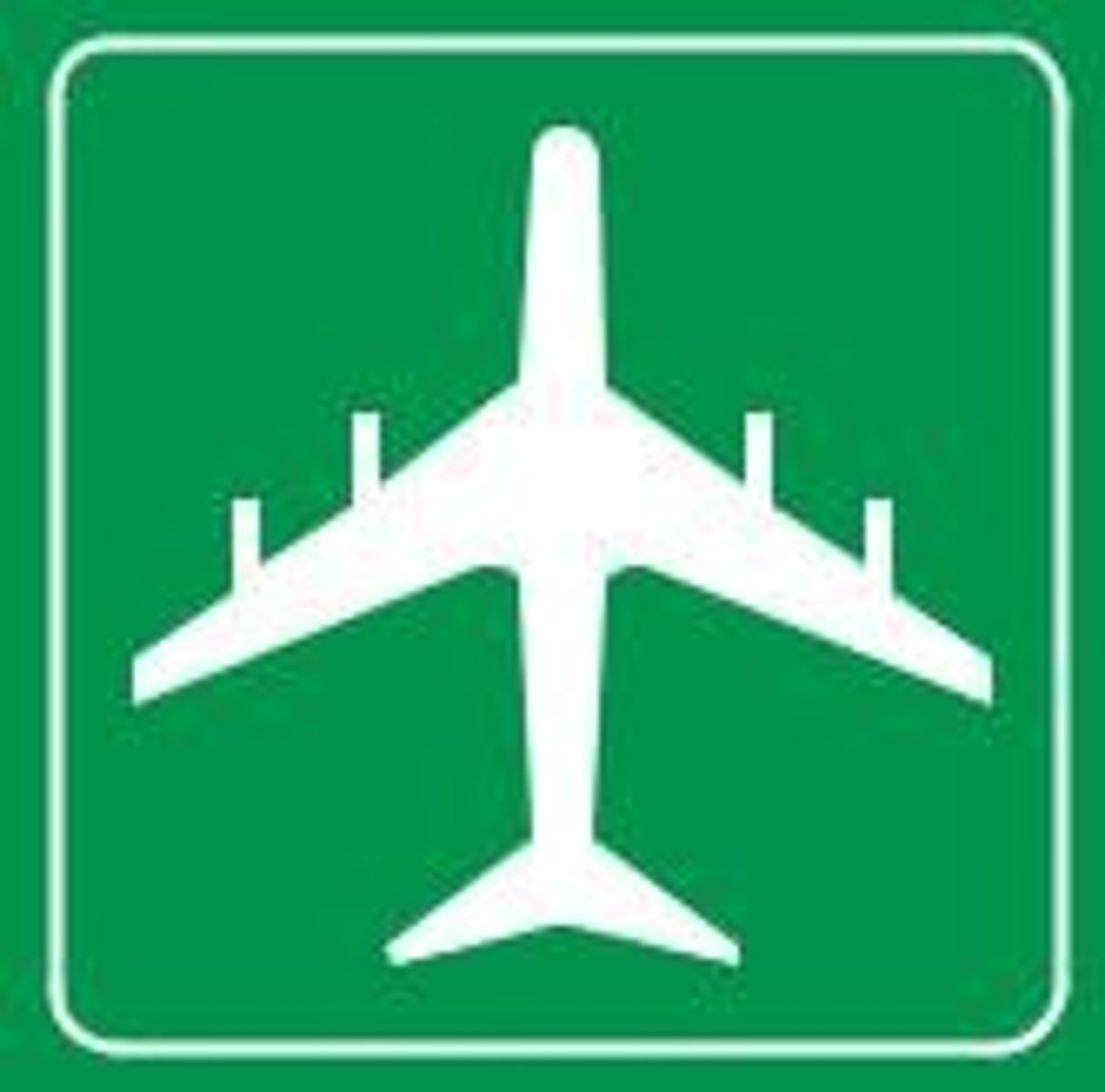
A driver in front of you is signaling with hand and arm pointing upwards, which means the driver wants to:
a. Slow down
b. Stop
c. Turn left
d. Turn right
d.
If your parked car rolls away and hits another vehicle, you should:
a. Get the other vehicle repaired
b. Sound horn to attract attention
c. Remove your car and go on your way
d. Report the incident to city police
d.
If your vehicle starts to hydroplane, you should:
a. Change the steering
b. Press down on your accelerating pedal
c. Apply the brakes
d. Slow down gradually
d.
A person under the age of 21 years:
a. Must have Zero Blood Alcohol Content
b. Can have a 0.08% Blood Alcohol Content
c. Can have a 0.04% Blood Alcohol Content
d. Can have a 0.02% Blood Alcohol Content
a.
In a roundabout, a driver must drive in:
a. A clockwise direction
b. The direction of oncoming vehicles
c. A counter-clockwise direction
d. Any direction
c.
If a car approaches you with bright headlights, you must __________, to prevent being temporarily blinded.
a. Look toward the right edge of the road
b. Look at the driver of the opposite vehicle
c. Look toward the left edge of the road
d. Look at the center of the road
a.
When there are three or more lanes going in one direction on a highway, vehicles passing others or turning left should use:
a. The middle lane
b. The right lane
c. The deceleration lane
d. The left lane
d.
When parking and leaving your vehicle on a highway or street, which of the following is not recommended?
a. Locking the ignition
b. Lowering the windows
c. Setting the brakes
d. Stopping the engine
b.
This arrow sign means:
a. Merge left
b. Go straight
c. Do not turn left or go straight
d. Turn left or go straight
d.
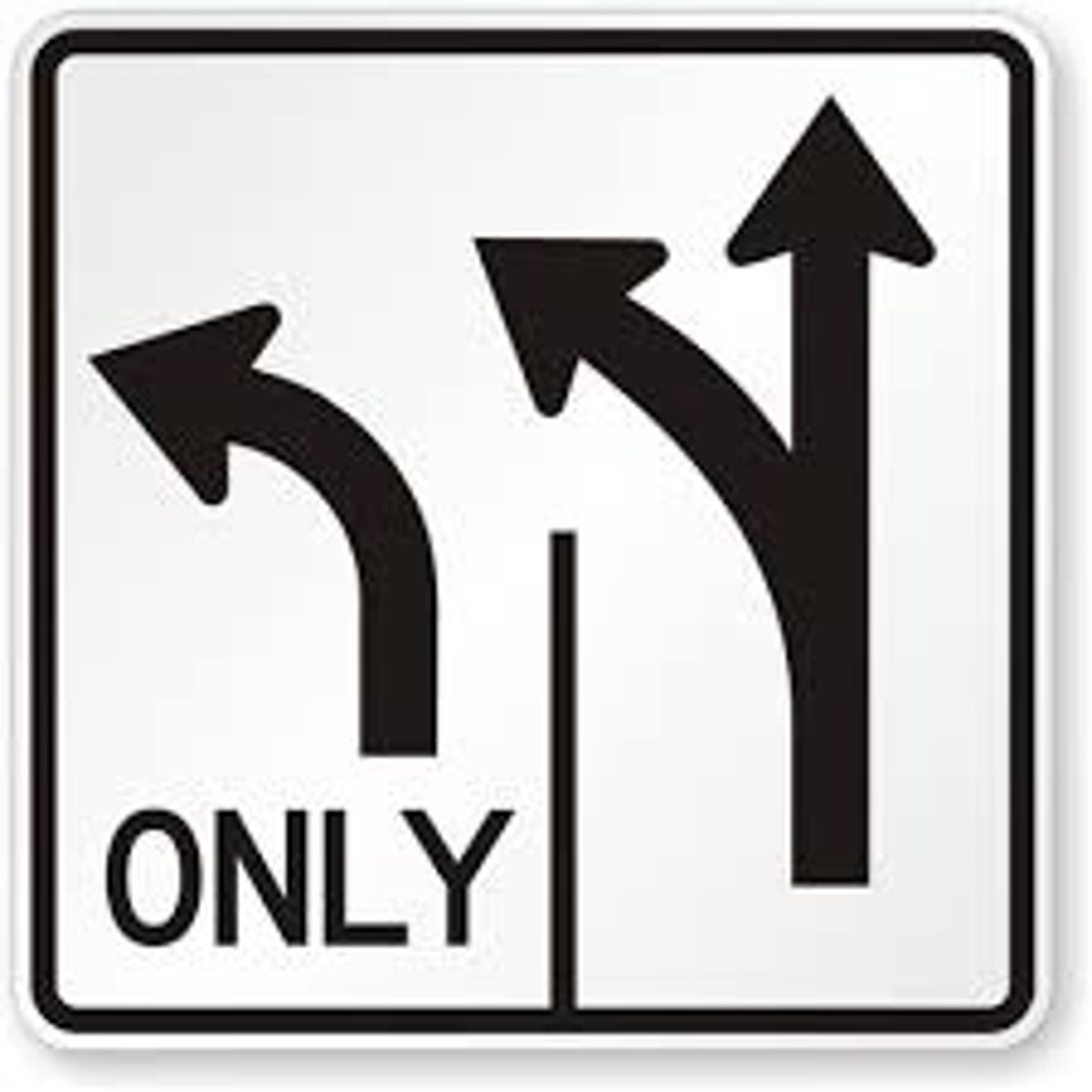
If you plan to turn beyond an intersection, you must:
a. Signal before passing through the intersection
b. Signal just after you pass through the intersection
c. Signal just before making a turn
d. Not give any turn signal
b.
When passing other traffic on a two-lane road:
a. Avoid passing other vehicles on two-lane roads; it is dangerous
b. Do not pull out to pass unless you know you have enough space to pull back
c. Always signal before passing
d. All of these answers are correct
d.
When turning left from a one-way road to another one-way road:
a. Bring your vehicle into the nearest left lane for traffic on the road you are entering
b. Bring your vehicle into the nearest right lane for traffic on the road you are entering
c. Turn into the lane just to the right of the center line
d. Turn into the lane just to the left of the center line
a.
What should you do if another driver tailgates your vehicle?
a. Raise your speed
b. Pull over to the side to allow the driver to pass
c. You must not allow the tailgater to pass you
d. Encourage the tailgater
b.
The first rule of a safe and legal turn is:
a. To move into the proper lane well before the turn
b. To cut corners while turning
c. To increase the speed
d. To reduce the speed
a.
Which of the following is not a safe situation for passing?
a. When pavement markings are broken white lines
b. When pavement markings are broken yellow lines
c. When moving through an intersection
d. When the vehicle ahead is moving below the safe speed
c.
What does this arrow mark sign indicate? Go only straight
Go only straight
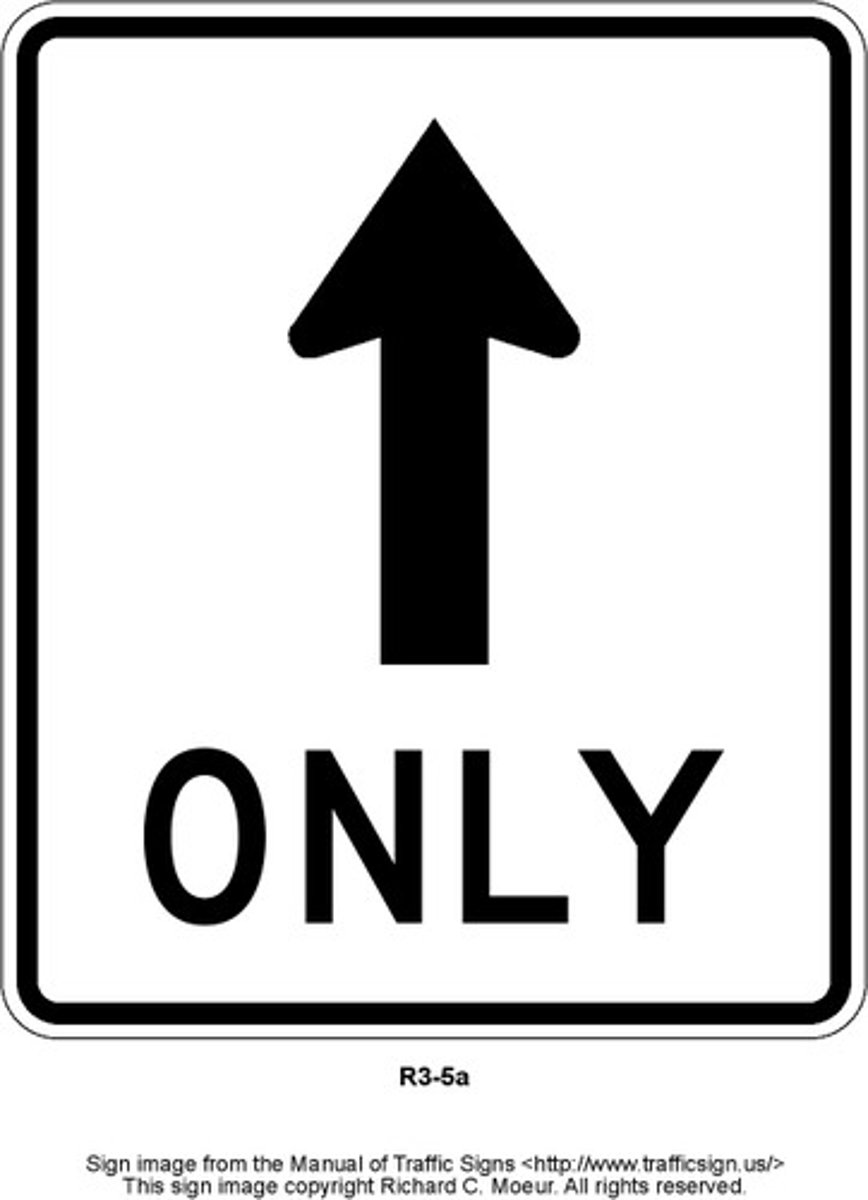
Which of the following statements is NOT true regarding the use of headlights?
a. Low-beams are used in city driving and driving in traffic on roadways
b. High-beams are used when traveling behind other vehicles
c. Low-beams are used when traveling in fog, rain, or snow
d. High-beams are used for open country driving when there is no traffic in sight
b.
_________ are the most likely places for car and motorcycle collisions to occur.
a. Intersections
b. Expressways
c. One-way roads
d. Roundabouts
a.
Lanes of traffic going in opposite directions are divided by:
a. White lane dividers
b. Yellow lane dividers
c. Black lane dividers
d. Red lane dividers
b.
High Occupancy Vehicles (HOV) lanes are reserved for:
a. Emergency vehicles
b. Farm machinery vehicles and trucks
c. Carpools and vehicles with more than one person
d. Heavy goods vehicles with less than three persons
c.
Following too closely behind a vehicle is also known as:
a. Aggressive driving
b. Defensive driving
c. Sidegating
d. Tailgating
d.
You must use high-beam lighting in all of following situations, except:
a. In construction areas
b. In fog, snow, or heavy rain
c. When there may be people along the side of the road
d. On unfamiliar roads
b.
What should you do if you are overtaking a bicycle and an oncoming vehicle is approaching at the same time?
a. You should leave a little room to the oncoming vehicle while overtaking the bicycle
b. You must overtake the bicycle first to give extra room to the oncoming vehicle
c. You must slow down and let the vehicle pass first to give extra room to the bicycle
d. You must sound your horn to alert the bicyclist
c.
This posted sign is a/an: speed limit
Speed limit on highways

Blind pedestrians may carry _________canes or use the assistance of guide dogs.
a. Red
b. Black
c. Green
d. White
d.
When you see a yield sign on your way or at an intersection, you must:
a. Slow down to a reasonable speed and yield right-of-way to all vehicles
b. Not proceed through the road or intersection
c. Slow down and change your lane position
d. Slow down and take a detour
a.
The wide white line painted across a traffic lane before you enter the intersection is known as:
a. Merge line
b. Yield line
c. Crosswalk line
d. Limit line
d.
A yield sign indicates that a driver must slow down when approaching an intersection and _________ if a vehicle or pedestrian with the right-of-way is approaching from another direction.
a. be prepared to make a turn
b. be prepared to come to a complete stop
c. be prepared to increase the speed
d. be prepared to make a U-turn
b.
What does this sign mean? Handycap
A disabled parking permit
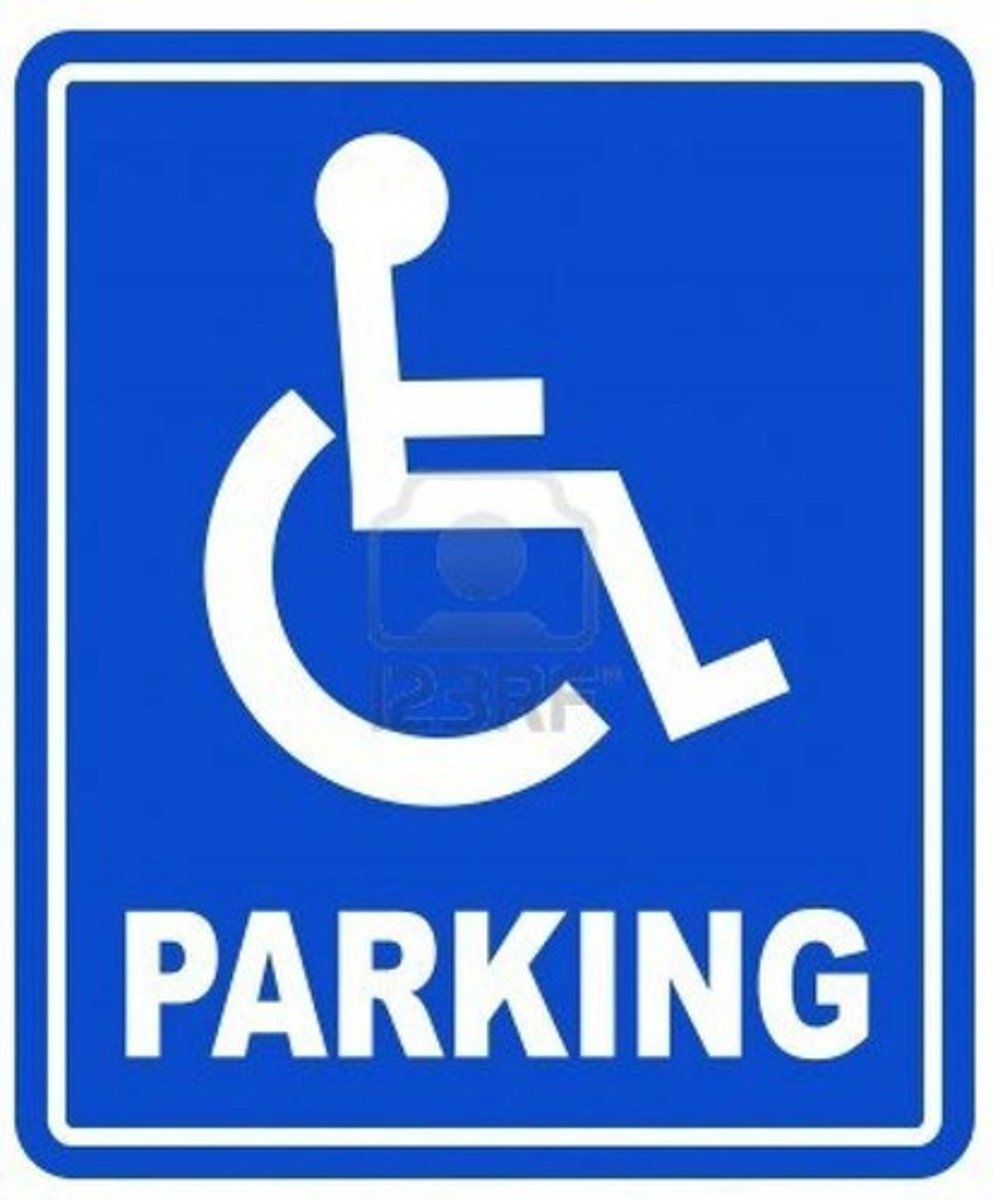
If a tire suddenly goes flat while driving, you must:
a. Try to increase the speed to control your vehicle
b. Try to move to the left side of the road
c. Try to stop your vehicle on the road
d. Hold the steering wheel tightly and keep the vehicle straight
d.
A center lane between lanes of traffic traveling in opposite directions may be designated for:
a. Left turns only
b. Right turns only
c. Passing
d. All of the above
a.
Before backing up your vehicle, you should look to the front, sides and rear, and continue to look _________ while backing.
a. to the front
b. into the side mirrors
c. to the sides
d. to the rear
d.
If you approach a roundabout, always enter to the _______ of the central island.
a. left
b. center
c. corner
d. right
d.
Large electronic flashing arrow panels may be used in work zones day and night to:
a. Divert drivers into work zones
b. Stop speeding drivers
c. Guide drivers into certain parking zones
d. Guide drivers into certain traffic lanes
d.
To turn left from a one-way street to another, a driver must begin the turn:
a. From the right lane and make the turn close to the left curb
b. From the right lane and make the turn close to the right curb
c. From the left lane and make the turn close to the left curb
d. From the left lane and make the turn close to the right curb
c.
Before reaching the crest of a hill or entering a curve, you must _________ and watch for oncoming vehicles.
a. Slow down, move to the right side of the road
b. Slow down, move to the left side of the road
c. Speed up, turn on the headlights
d. Speed up, change gears
a.
When should you yield to another driver at an intersection?
a. If the driver is just starting to enter the intersection
b. If the driver is to your right and reaches the intersection at the same time as you do
c. If the driver reaches the intersection before you
d. All of the above
d.
A vehicle's stopping distance is equal to:
a. the braking distance + reaction distance
b. the braking distance
c. the braking distance + following distance
d. the reaction distance + following distance
a.
If you are approaching a stop sign, you must:
a. Stop at the broken yellow stop line
b. Stop at the solid white limit line
c. Stop at the broken white limit line
d. Stop at the edge of the road
b.
All regulatory devices on the road instruct you:
a. Of hazardous conditions or the possibility of hazardous conditions
b. In finding your way safely or provide information to make your trip more comfortable
c. To stop, proceed in a certain direction, or limit your speed
d. None of the above
c.
When should you switch on your high-beam headlights?
a. When driving in open country or on dark city streets
b. At night when it rains
c. Always at night
d. All of the above
a.
When you turn from a high speed, two-lane roadway, _______ if you have traffic following you.
a. Try to quickly slow down your vehicle
b. Try to increase the speed of your vehicle
c. Try to apply brakes and keep the steering steady
d. Try not to slow down your vehicle too quickly
d.
A single solid white line across a road at an intersection means that a motorist must _________ for a traffic signal or sign.
a. Cross the line
b. Slow down after crossing the line
c. Stop after the line
d. Stop behind the line
d.
Which of these signs directs you to a hospital?
Blue and white signs direct you to services, such as gas, food, motels and hospitals.
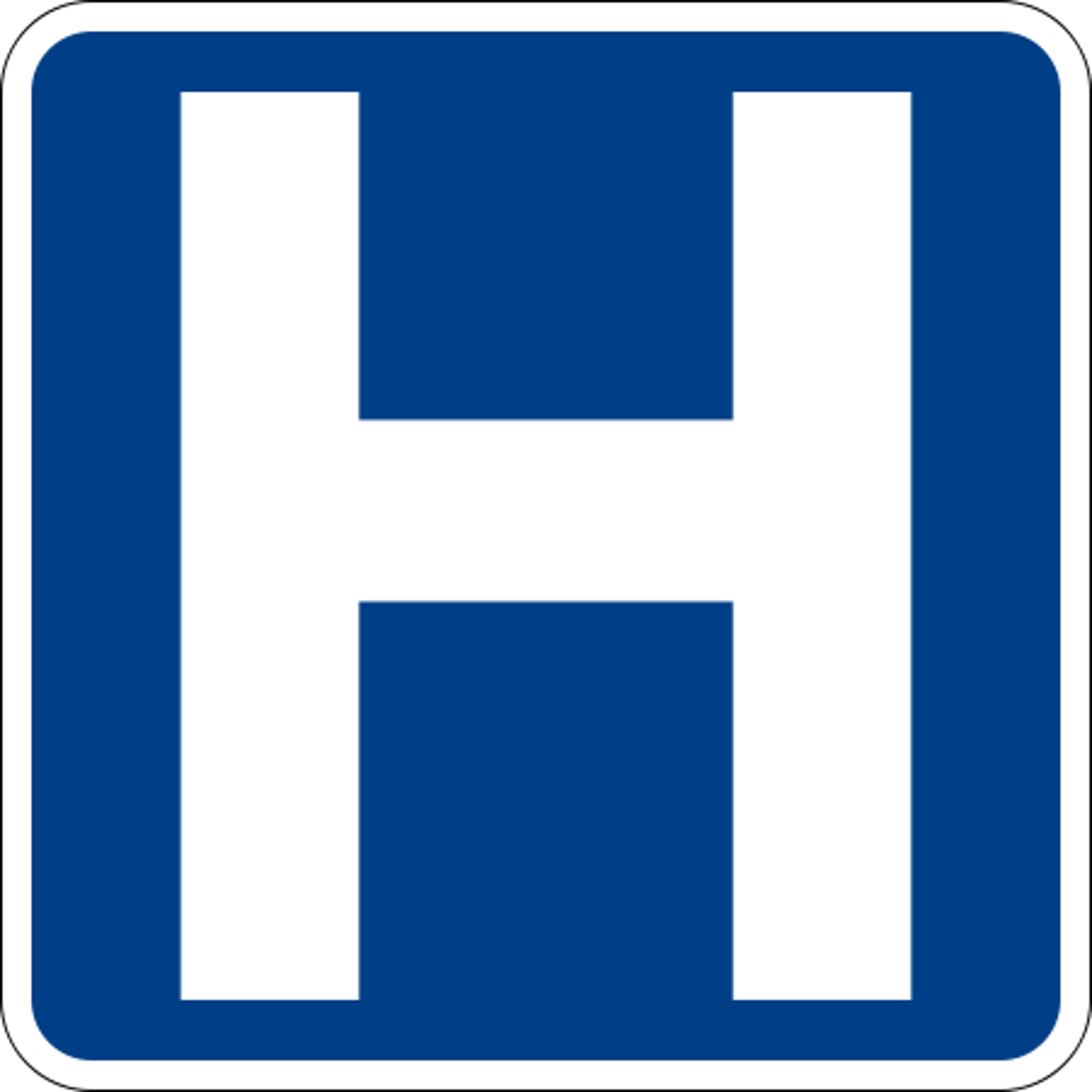
A steady red arrow signal means
you must stop and you cannot turn in the direction of the arrow
Any person who willfully flees or attempts to evade a peace officer performing their duties is guilty of a misdemeanor punishable by
1 year of imprisonment in county jail
which of the following statements about lane marking is true?
A solid white line between lane of traffic means that you should stay in your lane unless a special situation requires you to change lanes
At 55 mph, under good conditions, your vehicle will travel about ____ feet in the time that it takes you to react to an object in your path and bring your vehicle to a complete stop.
400
A double solid white line
separates two lanes traveling in the same direction, but crossing the line is prohibited
Whats the intoxication level thats considered Intoxicated?
a. .07
b. .06
c. .08
d. .09
c.
when can you leave a child locked in a car?
if someone 12 years old or older is watching
Your vehicle breaks down on a freeway. You are not able to move the vehicle off the road completely as the road shoulder is too narrow. What is the best thing to do?
a. leave the vehicle immediately and wave at drivers to let them know you are blocking the lane
b. stay inside your vehicle with the selt belt on until help comes
c. Exit on the right side of your vehicle and proceed to safe place.
c.
you are driving on the freeway and notice another driver using a handheld cell phone. Whhat is the best thing to do?
a. alert the police immediately
b. increase your following distance
c. honk your horn and wave to the driver to get off the phone
b.
In California, when are you allowed to drive to the left of two solid yellow lines?
a. Never
b. When you are in a carpool/HOV lane with a designated entrance on the left
c. When you are passing another vehicle
b.
Can you pass another vehicle when approaching a curve or a hill?
a. Yes, but you may only pass on the right.
b. Yes, but only if there is enough space.
c. No, never.
b.
You must not follow within _______ of any emergency vehicle with a siren or flashing lights.
a. 200 feet
b. 300 feet
c. 100 feet
b.
In which of the following places is a U-turn permitted?
a. On a railroad crossing
b. Across a double yellow line
c. On a one-way street
b.
If you are convicted of seriously injuring someone while attempting to evade a law enforcement pursuit, you may be fined at least
a. $2,000.
b. $3,000.
c. $4,000.
a.
You should cut your speed in half when the road is
a. packed with snow.
b. icy.
c. wet.
a.
A _________ indicates the outer edge of a roadway, and it may be crossed only by traffic moving to or from the shoulder.
a. solid yellow line
b. broken white line
c. solid white line
c.
If you are convicted of reckless driving that resulted in injury to someone, you may
a. be sent to jail and/or pay a hefty fine.
b. lose your license for life.
c. attend an interview at the DMV.
a.
If you are found guilty of driving without wearing a seat belt, you will be fined up to _____ if this was your first offense.
a. $20
b. $50
c. $100
a.
On one-way roads, yellow lines are used as
a. left-edge lines.
b. center lines.
c. right-edge lines.
a.
You may drive off of the paved roadway to pass another vehicle:
a. If the shoulder is wide enough to accommodate your vehicle.
b. If the vehicle ahead of you is turning left.
c. under no circumstances
c.
You are approaching a railroad crossing with no warning devices and are unable to see 400 feet down the tracks in one direction. The speed limit is:
a. 15 mph.
b. 20 mph.
c. 25 mph.
a.